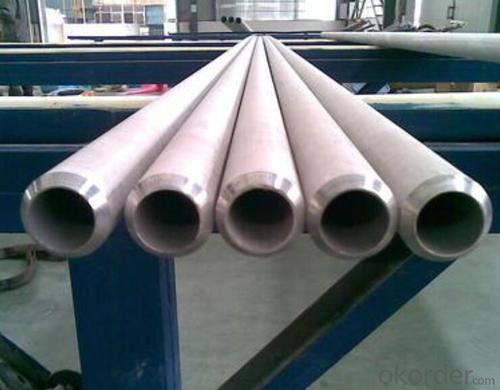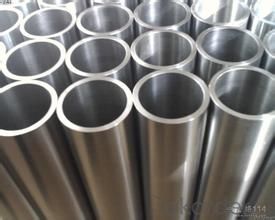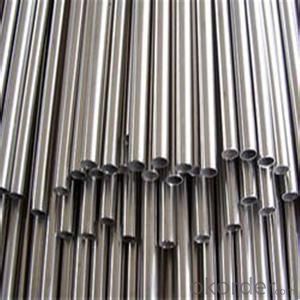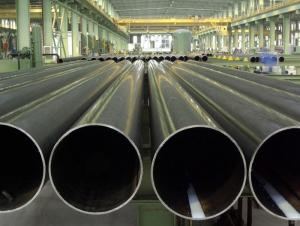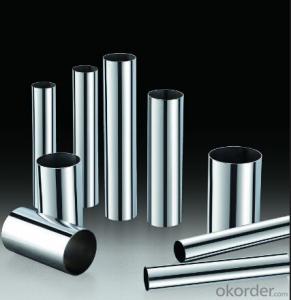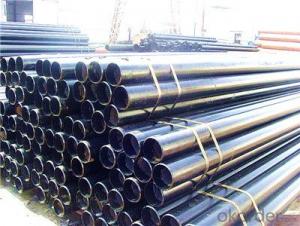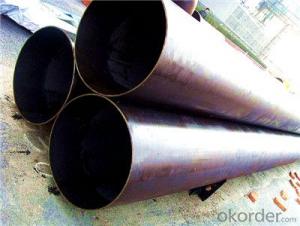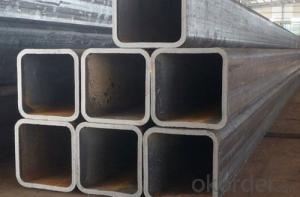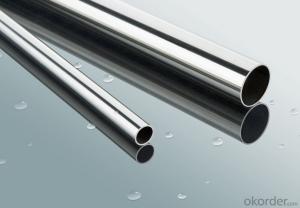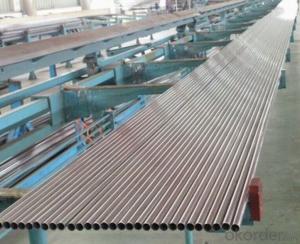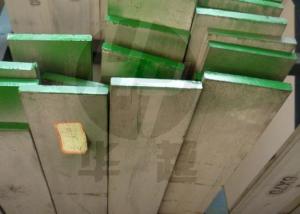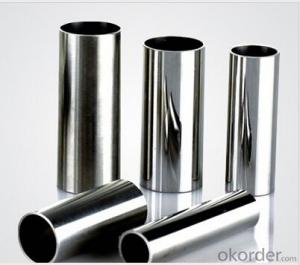Stainless Seamless Steel Tube With High Quality
- Loading Port:
- China main port
- Payment Terms:
- TT or LC
- Min Order Qty:
- 100 m.t.
- Supply Capability:
- 10000 m.t./month
OKorder Service Pledge
OKorder Financial Service
You Might Also Like
1、Structure of Seamless Pipe ASTM A106/53:
Seamless pipe is formed by drawing a solid billet over a piercing rod to create the hollow shell. As the manufacturing process does not include any welding, seamless pipes are perceived to be stronger and more reliable. Historically seamless pipe was regarded as withstanding pressure better than other types, and was often more easily available than welded pipe.
2、Main Features of the Seamless Pipe ASTM A106/53:
• High manufacturing accuracy
• Good visual effect
• Reasonable price
3、Seamless Pipe ASTM A106/53 Specification:
Standard | GB, DIN, ASTM ASTM A106-2006, ASTM A53-2007 |
Grade | 10#-45#, 16Mn 10#, 20#, 45#, 16Mn |
Thickness | 8 - 33 mm |
Section Shape | Round |
Outer Diameter | 133 - 219 mm |
Place of Origin | Shandong, China (Mainland) |
Secondary Or Not | Non-secondary |
Application | Hydraulic Pipe |
Technique | Cold Drawn |
Certification | API |
Surface Treatment | factory state or painted black |
Special Pipe | API Pipe |
Alloy Or Not | Non-alloy |
Length | 5-12M |
Outer Diameter | 21.3-610mm |
Grade | 20#, 45#, Q345, API J55, API K55, API L80, API N80, API P110, A53B |
Standard | ASME, ASTM |
1) Material:20#(ASTM A 106/A53 GRB.API5LGRB,GB),45#,16Mn,10#.
2) Specification range:OD:21.3-610mm,WT:6-70mm,length:6-12m or according to the requirement of clients.
3) Excutive standards:GB,ASME API5L.ASTM A 106/A53,Despite of the above standards,we can also supply seamless steel pipe with standard of DIN,JIS,and so on,and also develop new products according to the requirements of our clients!
4、Packaging & Delivery
Packaging Details: | seaworthy package,bundles wrapped with strong steel strip |
Delivery Detail: | 15-30days after received 30%TT |
5、FAQ of Seamless Pipe ASTM A106/53:
①How is the quality of your products?
Our products are manufactured strictly according to national and internaional standard, and we take a test on every pipe before delivered out. If you want see our quality certifications and all kinds of testing report, please just ask us for it.
Guaranteed: If products’ quality don’t accord to discription as we give or the promise before you place order, we promise 100% refund.
②How about price?
Yes, we are factory and be able to give you lowest price below market one, and we have a policy that “ for saving time and absolutely honest business attitude, we quote as lowest as possible for any customer, and discount can be given according to quantity”,if you like bargain and factory price is not low enough as you think, just don’t waste your time.Please trust the quotation we would give you, it is professional one.
6、Seamless Pipe ASTM A106/53 Images:
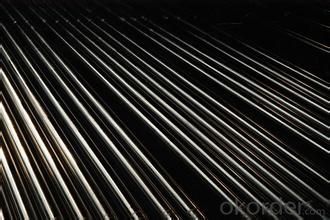

- Q: How do you prevent clogging in stainless steel pipes?
- To prevent clogging in stainless steel pipes, regular maintenance is essential. This includes flushing the pipes with hot water regularly to remove any potential buildup. Additionally, avoiding the disposal of grease, oil, or large solid particles down the drain is crucial. Installing screens or traps at the drains can also help to catch any debris before it enters the pipes.
- Q: Are stainless steel pipes resistant to scaling and pitting?
- Yes, stainless steel pipes are highly resistant to scaling and pitting. Stainless steel is known for its excellent corrosion resistance properties, which make it highly durable and suitable for various applications, including pipe systems. The presence of chromium in stainless steel forms a protective layer of chromium oxide on the surface, preventing the formation of rust and corrosion. This protective layer makes stainless steel pipes highly resistant to scaling, which is the formation of hard mineral deposits on the inner surface of pipes. Additionally, stainless steel pipes are also resistant to pitting, which is the localized corrosion that occurs as small holes or pits on the pipe's surface. Therefore, stainless steel pipes are an ideal choice for industries or applications where corrosion resistance is crucial, such as water distribution systems, chemical processing plants, and oil and gas pipelines.
- Q: Are stainless steel pipes suitable for wastewater treatment facilities?
- Stainless steel pipes are a great fit for wastewater treatment facilities due to their exceptional corrosion resistance. This quality makes them perfect for managing highly corrosive wastewater. Their ability to resist chemicals and acids prevents deterioration, minimizing the chances of leaks and contamination. Moreover, stainless steel pipes are hygienic and effortless to clean, which is vital in maintaining cleanliness at wastewater treatment facilities. Furthermore, their high strength-to-weight ratio enables easy installation and reduces the necessity for extra support structures. Hence, stainless steel pipes are a dependable and long-lasting option for wastewater treatment facilities.
- Q: What are the different surface finishes available for stainless steel pipes?
- Stainless steel pipes come with various surface finishes, each with its own unique characteristics and applications. Firstly, there is the mill finish, which is the basic finish after manufacturing. It has a dull and rough appearance, suitable for applications where aesthetics are not a major concern. Secondly, the brushed finish, also known as satin finish, is achieved by brushing the pipe with abrasive material. This creates a smooth, brushed appearance with fine lines in one direction. It is commonly used in architectural applications for a more polished look compared to the mill finish. Next is the mirror finish, which is the most reflective surface option. It is achieved by progressively polishing the surface to a high gloss. This finish is commonly used in decorative applications, providing a sleek and reflective appearance. The polished finish falls between the brushed and mirror finishes. It is achieved by polishing the surface to a smooth and shiny appearance using finer abrasives than the brushed finish. This finish is often chosen when a more refined, but not overly reflective, look is desired. The bead blasted finish involves blasting small glass beads against the surface, creating a uniform matte appearance. It is commonly used in industrial applications where a non-reflective surface is required, such as in food processing or pharmaceutical industries. Lastly, there is the electropolished finish, which is a specialized surface finish involving electrochemical polishing. It removes imperfections, enhances corrosion resistance, and creates a smooth and bright appearance. This finish is commonly used in industries with high sanitary standards, like pharmaceutical and biotechnology. These are just a few examples of the available surface finishes for stainless steel pipes. The choice depends on specific application requirements such as aesthetics, corrosion resistance, and cleanliness.
- Q: Can stainless steel pipes be used for natural gas systems?
- Yes, stainless steel pipes can be used for natural gas systems. Stainless steel is highly resistant to corrosion and can withstand high pressure and temperature, making it a suitable material for transporting natural gas. The smooth inner surface of stainless steel pipes also allows for efficient gas flow, minimizing the risk of blockages or obstructions. However, it is important to ensure that the stainless steel pipes used meet the specific standards and codes required for natural gas systems to ensure safety and compliance.
- Q: Are stainless steel pipes suitable for extreme weather conditions?
- Indeed, extreme weather conditions pose no challenge to stainless steel pipes, as they are highly suitable. Renowned for their remarkable corrosion resistance, stainless steel pipes are perfectly equipped to endure severe weather conditions such as extreme temperatures, heavy rainfall, and high levels of humidity. Moreover, the exceptional strength and durability of stainless steel pipes enable them to withstand the impact of powerful winds, storms, and other extreme weather phenomena. Furthermore, stainless steel remains unaffected by UV radiation, ensuring that it will not deteriorate or lose its color when exposed to intense sunlight. Consequently, stainless steel pipes prove to be a dependable and enduring choice for any application requiring resistance to extreme weather conditions.
- Q: What is the difference between Type 304H and Type 316H stainless steel pipes?
- Both Type 304H and Type 316H stainless steel pipes are high carbon versions of their respective stainless steel grades, but they have some distinct differences. To begin with, Type 304H stainless steel pipe is classified as an austenitic stainless steel with 18-20% chromium and 8-10.5% nickel. It boasts a maximum carbon content of 0.04-0.10%, which contributes to its improved strength at high temperatures and resistance against sensitization. Sensitization occurs when stainless steel is exposed to elevated temperatures, leading to corrosion along the grain boundaries. Consequently, Type 304H is a suitable choice for applications in the chemical processing industry that involve high temperatures. On the contrary, Type 316H stainless steel pipe is also an austenitic stainless steel but contains higher concentrations of chromium (16-18%), nickel (10-14%), and molybdenum (2-3%). The inclusion of molybdenum significantly enhances the corrosion resistance of Type 316H, particularly in chloride-rich environments. Thus, Type 316H is well-suited for applications that demand exceptional resistance to corrosion, such as marine environments or exposure to acidic or alkaline solutions. To summarize, the primary distinction between Type 304H and Type 316H stainless steel pipes lies in their chemical compositions and the resulting properties. Type 304H offers improved strength at high temperatures and resistance against sensitization, whereas Type 316H provides superior corrosion resistance, particularly in chloride-rich environments. The selection between the two depends on specific application requirements, including temperature, corrosion resistance, and environmental conditions.
- Q: Can stainless steel pipes be pickled and passivated?
- Yes, stainless steel pipes can be pickled and passivated. Pickling is a process that removes impurities and scale from the surface of stainless steel, while passivation is a treatment that forms a protective oxide layer on the surface to enhance corrosion resistance. This process is commonly used in industries such as oil and gas, chemical, and food processing to ensure the cleanliness and longevity of stainless steel pipes. Pickling and passivation can be done using a variety of acidic solutions and techniques, depending on the specific requirements of the pipes and the desired outcome.
- Q: What is the weight of stainless steel pipes?
- The weight of stainless steel pipes can vary depending on the size, thickness, and length of the pipes. It is important to consider these factors in order to determine the exact weight of stainless steel pipes.
- Q: What is the chemical composition of stainless steel pipes?
- Stainless steel pipes are primarily composed of iron, with a minimum of 10.5% chromium content. Other elements such as nickel, manganese, carbon, and small amounts of other elements are also present in varying quantities depending on the specific grade and intended application of the stainless steel.
Send your message to us
Stainless Seamless Steel Tube With High Quality
- Loading Port:
- China main port
- Payment Terms:
- TT or LC
- Min Order Qty:
- 100 m.t.
- Supply Capability:
- 10000 m.t./month
OKorder Service Pledge
OKorder Financial Service
Similar products
Hot products
Hot Searches
Related keywords



